What Causes Lightning and Thunder?
LIGHTNING IS A DANGEROUS but intriguing weather phenomenon. It results from electrical currents within a storm cloud, releasing tremendous amounts of energy that can strike the ground. In the U.S., more than 80 deaths per year are due to lightning. Although this number is much less than those killed simply by extreme heat and extreme cold, lightning is responsible for more deaths than any other severe weather in the U.S.
How Is Lightning Generated?
Lightning is a sudden and large discharge of electrical energy generated naturally within the atmosphere, typically expressed as a bolt of electricity that flashes briefly and then is gone. Most lightning occurs as cloud-to-cloud lightning or occurs within a single cloud, but about 25% of lightning strikes the ground (called cloud-to-ground lightning). Some lightning is less discrete, appearing to form diffuse sheets of lightning, called sheet lightning.
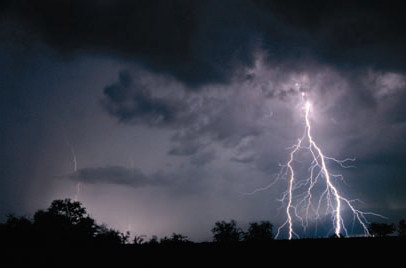
1. Most lightning occurs as a single discrete bolt that can be relatively straight or extremely irregular with many obvious branches. Lightning is associated with cumulonimbus clouds, the kind that form thunderstorms. Ice particles in the upper part of such clouds have a positive electrical charge, but the charge is mostly negative in the lower cloud where there is no ice. This charge separation is believed to happen because of the Bergeron process and different physical properties of ice particles and liquid water, but the exact process is unknown. The charge imbalance between the top and bottom of the cloud sets in motion a specific sequence of events, depicted in the series of figures below.
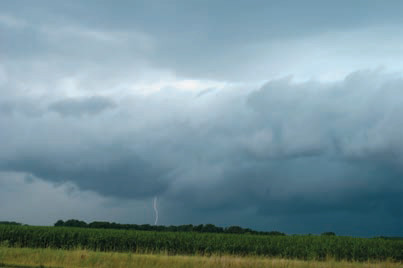
2. As a result of this charge imbalance, there is an excess of positive charges in the top of the cloud relative to the bottom of the cloud. Usually the Earth has a negative charge too, but as the cloud passes over a place, the negatively charged cloud base induces a positive charge directly below, and for several kilometers around, the cloud.
3. Recall that conduction requires energy transfer from one molecule to another, and therefore is most efficient in metals and other conductive materials. Air is a poor electrical conductor, so the flow of electricity through air cannot occur until the electrical potential becomes great enough to overcome the insulating effect of air.
4. Lightning starts with negative charges near the base of the cloud. The negative charges begin to form an invisible channel of ionized molecules through the air, from the base of the cloud toward the positively charged ground. As the channel develops, it separates into a series of branches, all still invisible, and repeat-edly starts and stops, advancing in a zigzag path, resembling a staircase. For this reason, it is called a stepped leader.
5. As the negatively charged stepped leader approaches the ground, positively charged streams of energy, called streamers, move upward to join the leader, commonly reaching up from the highest object on the ground, such as a tree, pole, bulding, or other tall object.
6. When the streamer makes contact with the stepped leader, it establishes а pathway of ionized molecules through which electricity can flow between the cloud and the ground.
7. Once the streamer and stepped leader meet, an electrical connection is established and electrons flow from the base of the cloud to the ground, but this flow is still invisible.
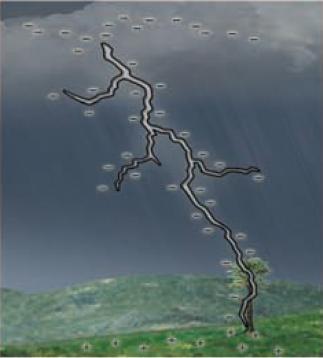
8. As the negative charge approaches the ground, the positive charge begins to flow upward In what is called a return stroke. The return stroke begins near the surface.
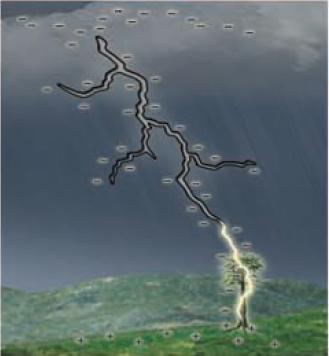
9. The return stroke is nearly Instantaneous, lighting up the sky with the discharge of energy. This is the main, bright flash we observe and recognize as lightning.
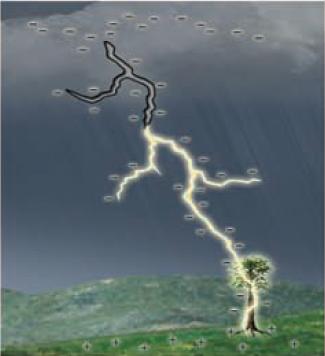
10. Once the electrical pathway is established, negative charges flow from the cloud to the ground, continuing to light up the sky with no obvious interruption after the return stroke.

11. In most cases, there is then a short pause, after which a new negatively charged leader, called a dart leader, starts down the established channel from the cloud to the ground.
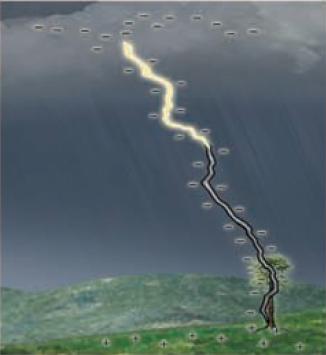
12. The discharge of the dart leader causes another flash of light, distinctly after the initial flash. Lightning strikes can have several or several dozen flashes from dart leaders.
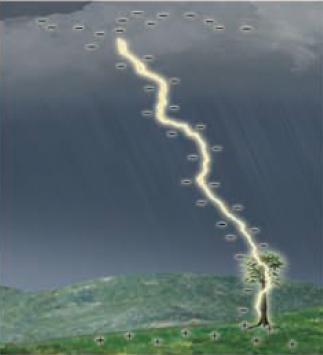
Thunder
Thunder results from rapid heating and expansion of the air along the path of the lightning bolt. Around a lightning discharge, the air temperature approaches 15,000–30,000°C, which is much hotter than the surface of the Sun. The extreme heat causes this air to expand quickly away from the lightning stroke, as shown by the red arrows on this figure.
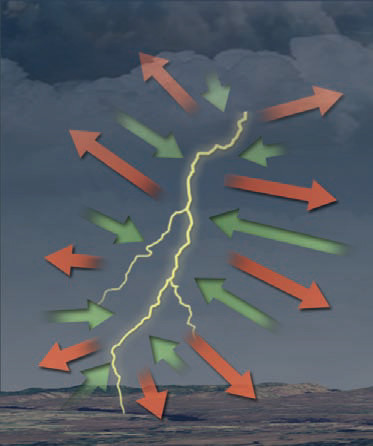
The expansion creates a momentary vacuum around the stroke. Almost instantly after the expansion, air rushes in from all sides toward the location where the lightning stroke passed. This is depicted by the green arrows. The sound of the matter in the various air streams colliding is what makes the sound of thunder.
Using Thunder to Estimate Distances to Storms
Lightning travels at the speed of light. At about 300,000 km/s (186,000 mi/s), it can be considered instantaneous. But thunder only travels at the speed of sound (1,225 km/hr, or 760 mi/hr). Since there are 3,600 seconds in an hour, this means that the sound of thunder travels about 1.7 km or 1 mile in 5 seconds. So if you start counting when you see lightning, and can count to five before you hear the thunder, you are one mile away from the lightning. But beware: lightning does not necessarily flow straight down the middle of a storm. The strike could be farther ahead or behind the cloud from which it originated.
Elves, Sprites, and Jets
Intense lightning can cause a flat disk of dim reddish light, called an elve, to form about 96 km above the Earth. The light of an elve radiates outward in every direction, spreading over a huge area of sky.
Immediately after a very energetic bolt of lightning strikes the ground, ghostly red lights, called red sprites, may shoot straight up from the top of a thunderhead. Some red sprites soar up to 100 km into the atmosphere.
Blue jets are dim, blue streaks of light. They look like quick puffs of smoke that burst out of a thunderhead, arc upward, and then fade away. Blue jets can climb as high as 30 km into the atmosphere.
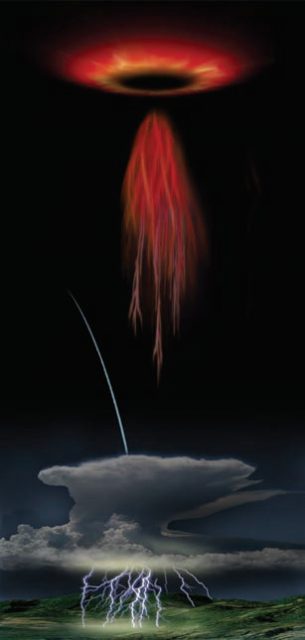
Safety Tips Around Lightning
Lightning is extremely dangerous. The map below shows the number of lightning-related fatalities for each state from 1959 to 2011. How dangerous are states with which you are familiar? What factors contribute to this spatial pattern? How at risk are you for lightning?
Conduction of electricity is easiest in solids and most difficult in gases. Therefore, direct contact with any solid object, particularly a tall one that conducts electricity well, (such as a tall metal post) is extremely dangerous in a thunderstorm. Tall objects minimize the distance that the electrical energy needs to travel through a gas (air) during lightning.

A house or other enclosed building offers the best protection from lightning. Open shelters on athletic fields, golf courses, and picnic areas provide little or no protection from lightning. When inside a building, stay away from windows and doors, and avoid contact with plumbing, corded phones, and electrical equipment. Basements are generally safe havens, but avoid contact with concrete walls that may contain metal reinforcing bars. A car is a relatively safe place, because the metal body and frame carry the electrical current if struck.
If no safe shelter is available, stay away from trees and other tall objects, and crouch down with your weight on your toes and your feet close together. Lower your head and get as low as possible without touching your hands or knees to the ground. Do not lie down!
Consider the 30-30 rule: if the time between seeing a flash and hearing the thunder is 30 seconds or less, the lightning is close enough to hit you, so seek shelter immediately. After the last flash of lightning, wait 30 minutes before leaving a shelter.